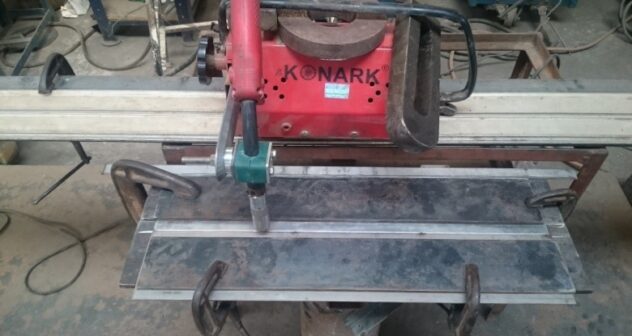 I received my MTech and Ph.D. Degree from the Department of Materials and Metallurgical Engineering, IIT Kanpur. I worked for an Indian Railways funded project under the Technology Mission for Railway Safety (TMRS) for my Ph.D. thesis. I was also involved in the development of a corrosion resistant rail which is now included in the IRS (Indian Railway Standard) Specification.
I received my MTech and Ph.D. Degree from the Department of Materials and Metallurgical Engineering, IIT Kanpur. I worked for an Indian Railways funded project under the Technology Mission for Railway Safety (TMRS) for my Ph.D. thesis. I was also involved in the development of a corrosion resistant rail which is now included in the IRS (Indian Railway Standard) Specification.
I joined the R & D Division of EWAC Alloys, Mumbai after completing my Ph.D. in 2008. During my tenure at the Materials Science Division of National Aerospace Limited (NAL), I worked on several case studies on aircraft and industry related failure and accident analysis.
At CMRIT, I recently completed a project funded by Department of Science and Technology, Government of India, titled “Effect of Various Parameters on the Liquid Metal Embrittlement of Stainless Steel when Welded to Galvanized Steel”. This project was helpful in understanding the effect of zinc on how it causes embrittlement or loss of ductility of stainless steel when it penetrates into the weld metal.
I am presently working on another funded project, again related to welding. This project is funded by the Naval Research Board, Ministry of Defense, Government of India. This project, titled, “Effect of multiple shot peening on the fatigue behavior of UNS S32760 and Ti-6Al-4V weld in sea water” is of huge practical importance as the welds in these alloys are subjected to premature fatigue failure in corrosive ocean environment.
I am currently heading the Centre of Excellence for Metallurgical Engineering at CMR Institute of Technology, Bengaluru. ‘I, along with my team, are instrumental in carrying out research in the areas of corrosion and welding. We are also working towards the development of new aluminum alloys and corrosion resistant coatings.
I have 18 publications in various international journals and conference proceedings to my credit and currently guiding 5 Ph.D. students registered under VTU.
I have delivered several invited lectures at various organizations like the R & D Division of Tata Steel, Jamshedpur, Vellore Institute of Technology, Tamil Nadu, at the Annual Assembly and International Conference of the International Institute of Welding, Chennai, at L & T Institute of Technology (LTIT), Mumbai, at the Indian Railway Fan Club Association (IRFCA) Convention, to name a few.
I am also a reviewer for various international journals like Tribology Transactions, Journal of Materials Engineering and Performance, Materials Science Forum, etc.

I always had a passion towards metallurgy when I was exposed to the depth of this subject during my under-graduation program. Because of my love for the subject, I decided to go for higher studies. After PhD, when I joined the R & D Division of EWAC Alloys Ltd., I realized how important metallurgy is for the weld properties. Welding has been one of my favourite subjects because of its huge practical applications. While at EWAC Alloys, I studied many technical books related to welding and learnt the art, science and technology of it. I have been instrumental in the development of various special purpose welding consumables for the R & D Division of EWAC Alloys Ltd. to cater to industries like oil and gas (ONGC), fertilizer (L & T Hazira), etc. Using my in-depth knowledge of metallurgy, I was able to meet the requirements for special properties in the weld like high impact toughness, pitting corrosion resistance, high ductility etc.
During my tenure at the Materials Science Division of National Aerospace Limited (NAL), I worked on several case studies on aircraft and industry related failure and accident investigations. One particular failure which I dealt with was the weld failure of an afterburner of a fighter aircraft which met with an accident. The accident investigation revealed that excessive service stresses led to the initiation of a fatigue crack at the weld root. The vibrating loads experienced by the aircraft resulted in the crack to grow and the afterburner part of the engine caught fire due to fuel leakage. Such huge losses and accidents can happen if the weld is subjected to unnatural service stresses.
The article related to this accident is published in Engineering Failure Analysis (https://www.sciencedirect.com/science/article/pii/S1350630713000320).
My practical experiences at EWAC Alloys Ltd. and NAL helped in understanding the industry related issues related to welding. I could relate welding and failure of industrial components. This inspired me to work towards writing project proposals to get grants for such industry related weld failures when I joined CMRIT in 2014.
The two GOI funded projects which I have undertaken are related to weld failure. I have recently completed a 3-year Department of Science and Technology (DST) funded project titled “Effect of Various Parameters on the Liquid Metal Embrittlement of Stainless Steel when Welded to Galvanized Steel” at CMRIT. I am presently working on another project, funded by the Naval Research Board, Ministry of Defence, Government of India. The project is titled, “Effect of multiple shot peening on the fatigue behaviour of UNS S32760 and Ti-6Al-4V weld in sea water”. I have been lucky enough to pursue a career which I always wanted to. Being a researcher and able to solve industry related issues is a challenge. However, it is rewarding at the same time.




